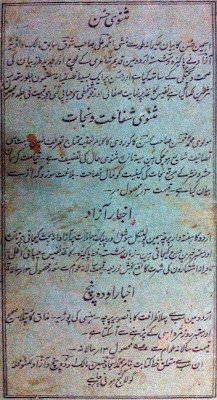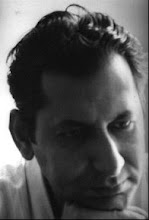My great-great-grandfather (سگڑدادا in Hindustani), Sheikh Kazim Ali Qais, was a well known poet and was considered among the better known people in Lucknow. He was a close friend of Taajdaaré Jaané Alam Sultan Mohammad Wajid Ali Shah Bahadur (that was the full title!) and Qais was give a jaagir by the State for his work in stylizing the Urdu kitaabat at that time.
This style was taught to his children, who taught their children. My dada taught Abi, who taught it to me. I think I am the only one who still writes like that among my generation in this family. My handwriting is awful - according to my grandfather and my father. Both wrote English and Urdu in a very perfect hand. I used to write a letter every week to my dada when I was 8-9 years old. One week in Urdu and one week in English. He sent my first Urdu letter back saying that my ن was of different sizes in the place where I had written پاکستان and, a few sentences later, had written جاپان — Years later, when he was about 93, I went to see him in Dhaka. I told him that I still remembered this ن incident. He picked up a paper and a pen, rested the paper against his shaking hand, and wrote ن four times ... and, despite his old age, they were almost 'equal' until you looked really hard. He smiled and said "I think my cigar smoking has begun to make my hands tremble a bit."
Unfortunately everyone writes Urdu so badly today that they think I write well. Here is an example of how Qais wrote his 'noons' & 'yays' to show the pronunciation from the way it was written.
Qais died when his children were very small. His eldest son, Munshi Ahmad Ali Shaoq Kidvai (pictured below) - a poet and a writer - was born in 1852 in Jiggaur.
Qais's younger son was my great-grandfather, Vahid Ali Abr Kidvai. Qais had a daughter, too, but in the shajrah that I have she was known only as 'dukhtar'.
I found Asad Ali Qidwai's photographs that her name was Kaneez Fatima and her daughter was Mahjabeen, a person that we all adored.
(Asad Ali Qidwai was my Dada's youngest brother. He was 4 years older to my father. They both married two sisters.)
The jaagir had almost no money when Shaoq was growing up - mainly because of his uncle's "behavior" (that is all that my Abi said to me … and he seemed ashamed to have even said this!) and his early days were spent with his naanihaal. He studied Arabic and Persian, went to secondary school in Unnao, learnt English at Badaayüñ where he also passed an 'Entrance Exam' which was considered to be wonderful in those days, particularly because of its English teaching. Later, the word 'Entrance Exam' became known as 'Intermediate Exam'.
Shaoq became a student of Nawab Muzaffar Ali Khan Aseer (who was, himself, a student of the famous Sheikh Ali Hamdani Mus'hafi). Another of Aseer's students was the legendary Munshi Ameer Ahmad Minai. The famous poet, Riaz Khairabaadi, was also one of Aseer's students in the beginning but was 'handed' to Ameer Minai for 'more teaching', according to his biography (which mentioned that Aseer possibly did not like Riaz's arguments).
Writing in Avadh Panch and in his own weekly paper, Aazaad, Ahmad Ali Shaoq had to leave all of this to get jobs in Faizabad and Partaab Ga∂h because of the lack of funds.
Nothing was left at all of the Jaagir by then. Shauq went on to stay with Munshi Imtiaz Ali Alavi (his wife's brother), who was a minister in Bhopal. Here Shaoq was appointed as Naeb Nazim, a post that was the equivalent of Deputy Collector. He worked there for 22 years. He then left to go to Rampur, where his brother Abr was a Court Justice in the time of Nawab Hamid Ali Khan.
Shaoq supervised the work on a lüghat that was being compiled in Rampur, but after 12 years, when the saazishoñ ki garm baazaari (to quote Naadim Sitapuri*) had started to brew, he left for Satrikh where he had a friend.
(Soon the Abr family was also forced to leave for Lucknow — devoid of all money, jewelry, belongings — after my grandfather, Safdar Ali, and his troubles with the new Nawab, once a close friend, began. (More on that in another post - just waiting to get some facts double-checked.)
Shaoq was accepted as being among the top writers in his time and for many years later. He wrote several ghazals. His deevaan (Faizaané Shauq) was published in Gonda in 1928 and some of his unpublished works are in the Library at Satrikh. Here is a shayr that I love from one of his ghazals:
صبا یہ چار سو جا جا کہ گلشن میں پکار آئ
! بہار آئ ! بہار آئ ! بہار آئ ! بہار آئ
However, despite his ghazals, it was his Masnavees that held the day.
Eight of Shaoq's masnavees are known by me to have been published. There may have been one more, according to an uncle of mine. But he remembered no name. This selection included Aalamé Khayaal - a work that was written in the feminine style of speech: Yes, there was a feminine style in Urdu, then: Women did not 'own' anything - a pity in today's terms, but accepted in those days - and, so, no possessive words were allowed. No izaafats! There were also words, like Nauj (نوج) … and many others … that were part of the female diction that were used in such works.
Aalamé Khayaal also talked about the love of a woman for her husband! A definite no-no in those days (and, perhaps even today in our literature, in spite of Ismat Chughtai's great work). This meant that a lot of people, including his friends, insisted that the book should not be published. But it was!
The booklet had an inset photograph of a young woman lying in bed. This was Shaoq's cousin's daughter, Mahlaqa (daughter of Hafiz Mahmood Ali), who also wrote the amazing Foreword. This was considered extremely risky at that time. Very few women in our culture really wrote very much. Mahlaqa's knowledge and understanding of Western Literature (and life, in general) was tremendous. She married my dada, Huzoor Abba.
I wish I had seen her, for I have heard such wonderful things about her from my father and all my older relatives. I went to see Atiya Faizi when she was in hospital and she spoke a lot about Huzoor Amma, too. Their friendship was wonderful. (English novelist Attiya Hosein عطیہ حسین, my cousin, was named after Atiya Faizi by my dadi). Her loving nature, the collection of all youngsters - nephews, nieces, servant's children - who were taught to read and write, her love of household parties and pranks, and the teaching of her greatest love, Indian Classical Music, to all her 'youngsters' who lived in her haveli. Playback Singer Talat Mahmood - her brother Manzoor's son - was taught by her and he spoke of her in many interviews.











3 Comments:
Semantic Memory + Episodic Memory = Declarative Memory. ROCKING!
19 June, 2012 19:31
Nothing better a tribute to your elders than writing about them, and equally enjoyable to read. thank you
17 April, 2020 17:37
Munshi Imtiaz Ali alavi sofi brother in law of shauq Kidwai is very ambiguous.
Sisters husband ;
Sister in laws husband, or
Wives brother?
07 May, 2020 00:37
Post a Comment
<< Home